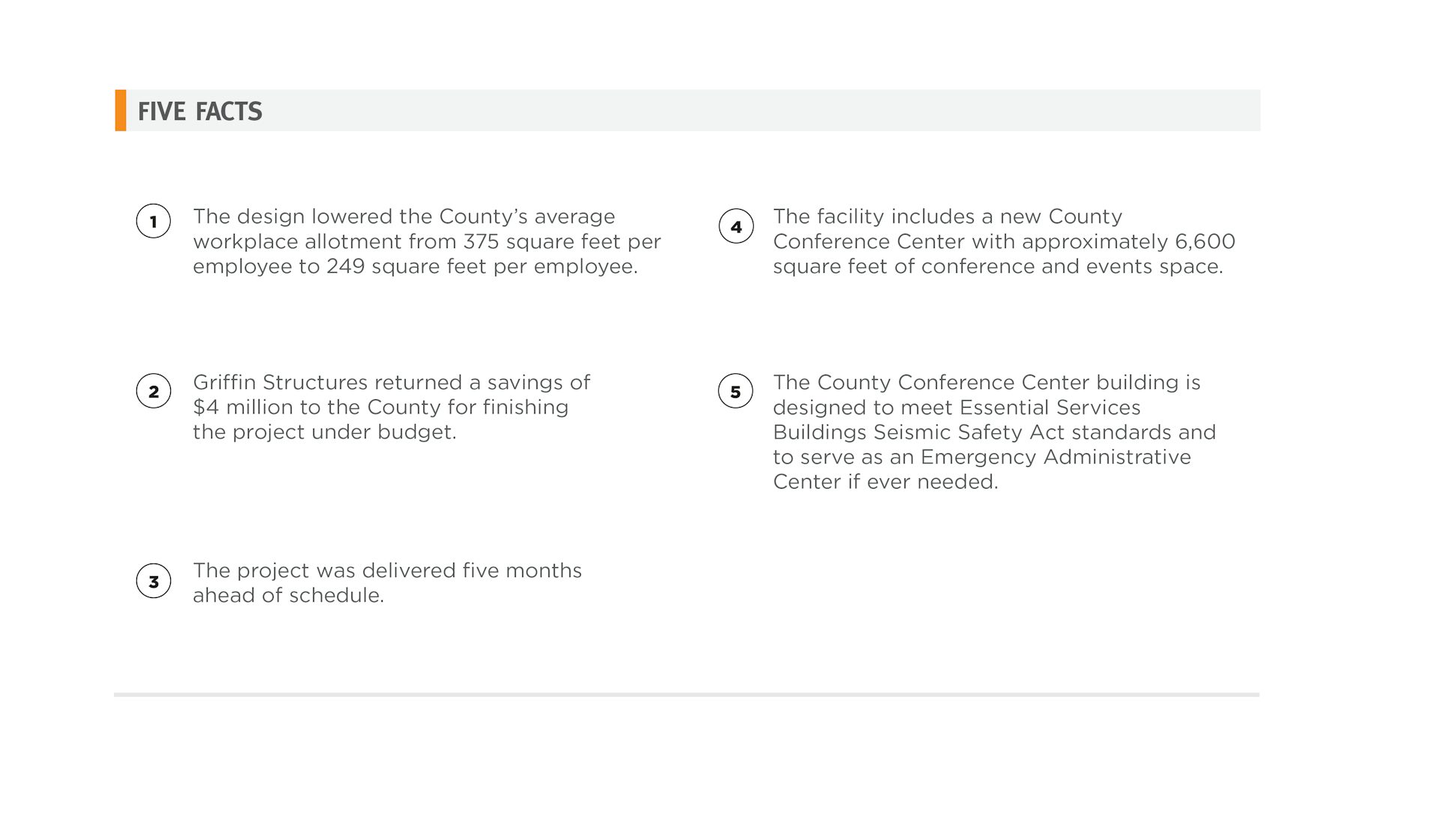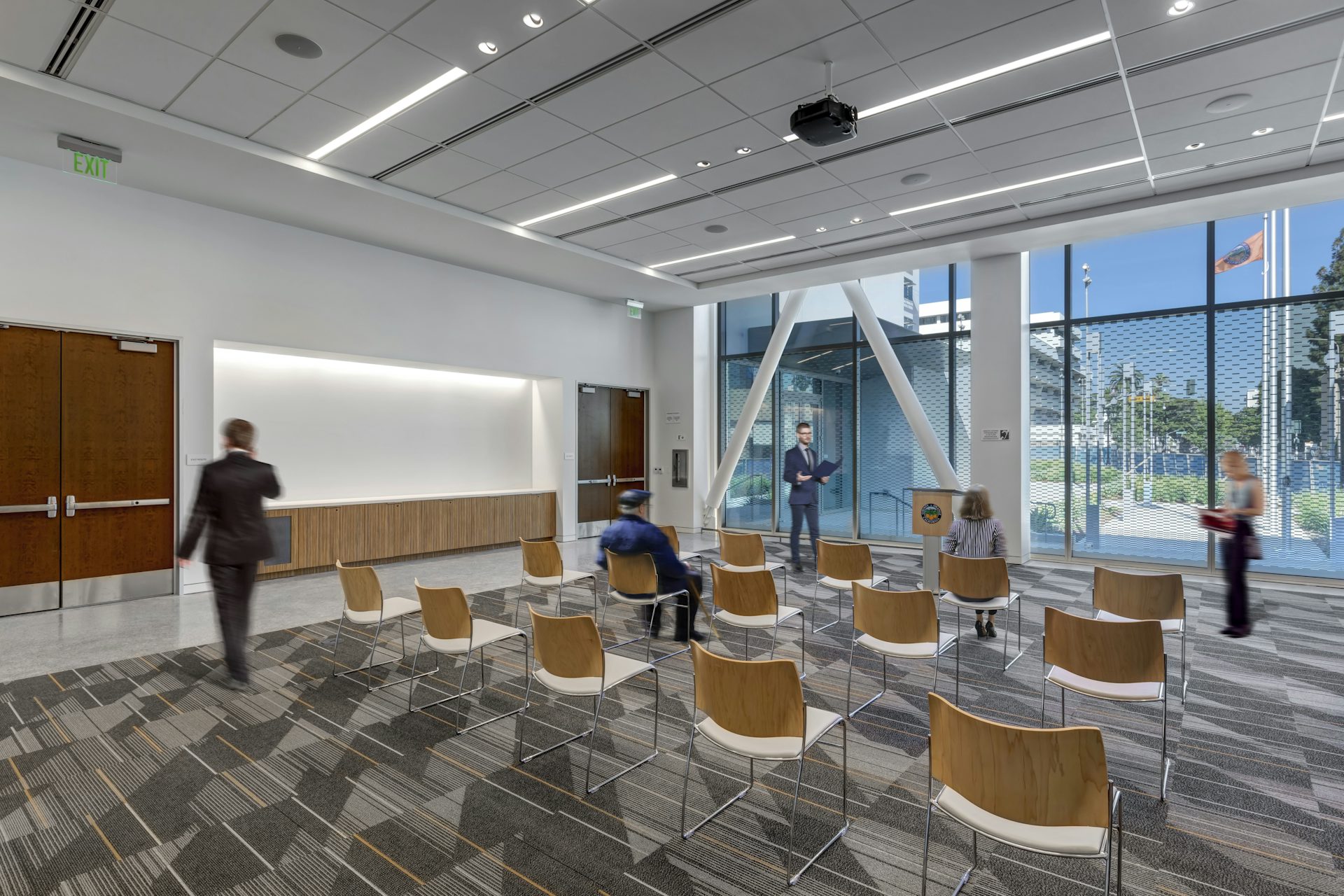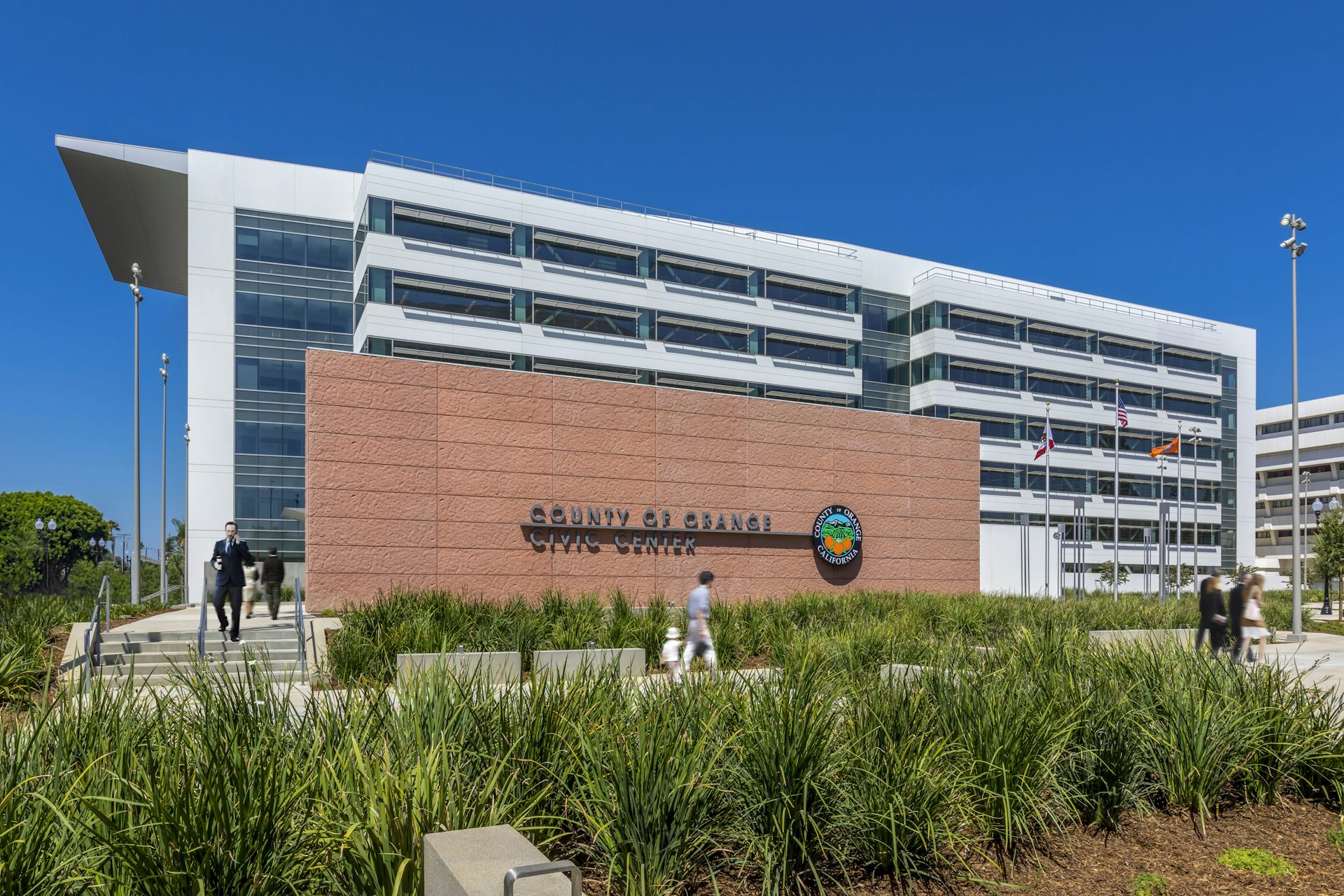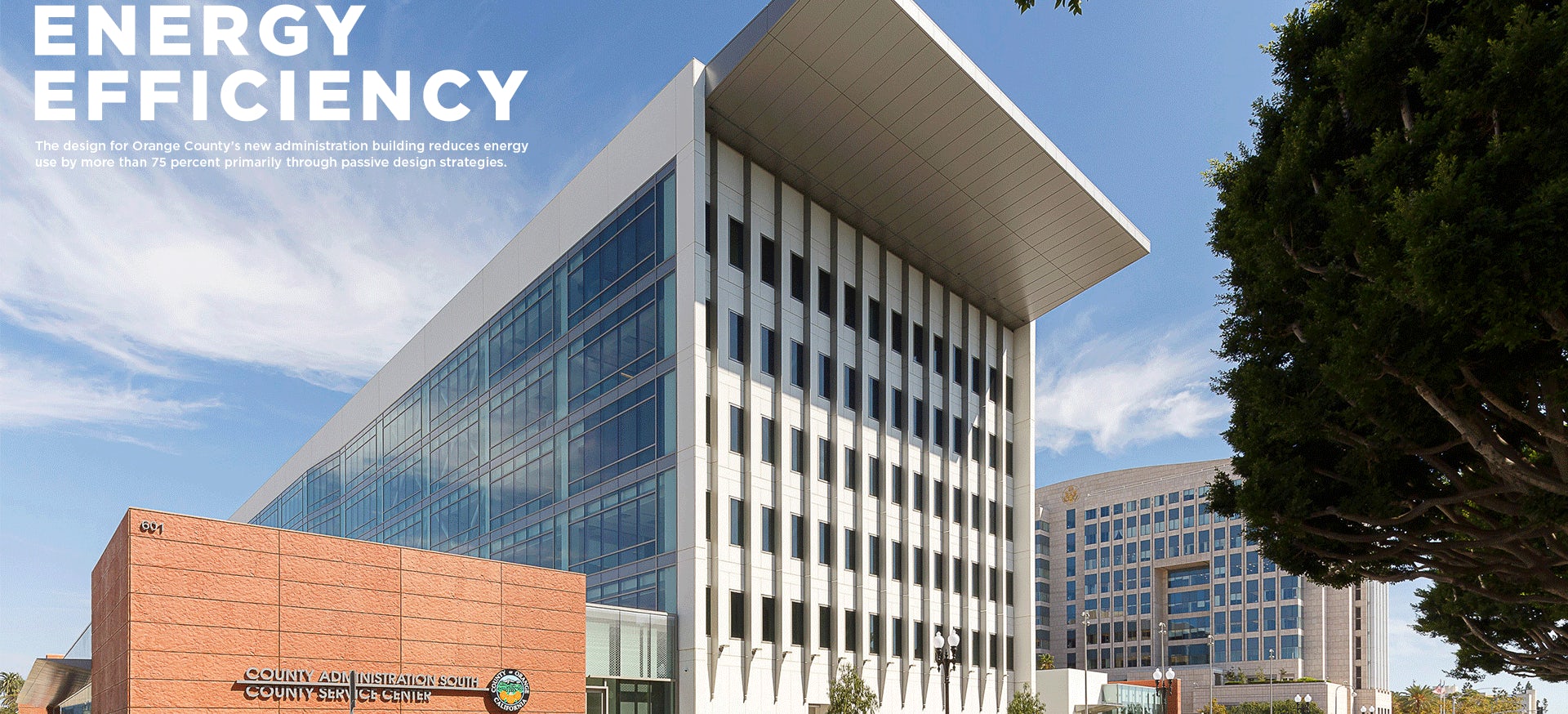Griffin Structures CEO Roger Torriero uses terms like “consistent” and “focused” when asked to describe the development process for the County of Orange’s new Administration South Building. The six-story, 250,000-square-foot structure built over two levels of underground parking is the result of 10 years of challenges and problem solving, representing the first phase of a 20-year master plan to reshape the County’s Civic Center real estate and its public interface.
The County was emerging from bankruptcy and there were several changes in County leadership during the course of the development. “It was necessary to stay the course and to never give up,” Torriero says. “The process was constantly moving and changing.”
A Model for Energy Efficiency
The design for Orange County’s new administration building reduces energy use by more than 75 percent primarily through passive design strategies.

Achieving the targets required clear communication about the goals with the different stakeholders and constant dialogue with LPA’s integrated team.
One outcome of the diligence of the development and design team: The Administration South Building, which opened in September, reduced energy use from an industry baseline by 77 percent. The building team achieved the result primarily through passive strategies, including proper building orientation, solar shading devices, an efficient envelope, natural daylighting and a workplace design that is coordinated with the passive systems. Without the aid of photovoltaic panels or alternative fuel sources, the building surpasses the AIA 2030 Commitment target of a 70 percent cut in fossil fuel use and targets LEED Gold certification.
“Given that this is a 50-year-plus building, energy efficiency was a priority of the process from the very start,” says LPA President Dan Heinfeld. “Achieving the targets required clear communication about the goals with the different stakeholders and constant dialogue with LPA’s integrated team.”
The Administration Building is the first phase of one of the largest public-private partnerships (P3) under development on the West Coast, the Civic Center Master Plan, created with Griffin Structures as lead developer, LPA as the design partner and Swinerton Builders as the general contractor. The Facilities Strategic Plan, developed over three years by Griffin and LPA, covers more than 16 County-owned buildings, 4,600 employees and more than 1.6 million square feet of space. Phase 2 of the master plan—a six-story, 250,000-square-foot sister building to the County Administration South complex—is under construction.
As a P3, any energy strategy needed to take into account the goals and interests of all the stakeholders. The agreement with the County included a guaranteed maximum price for the project—the energy strategy couldn’t add cost. To work within the framework, the design needed to cut the County’s maintenance and operation (M&O) costs and address inefficiencies throughout the County’s operations. According to Karen Thomas, LPA Director of Workplace, the average age of the buildings included in the Facilities Strategic Plan was more than 50 years.


“Not only did we engineer this building from a design standpoint, but we engineered it financially,” Torriero says. “And part of the justification and impetus for developing this building was to resolve and reset the clock on the M&O side of the business.”
The ability to cut M&O costs paid direct benefits for the County. “We were able to use those deferred costs to help finance this structure,” Torriero says. “There was an economic benefit beyond the obvious in solving for energy efficiencies and operating costs.”
Every element of the project was evaluated in the context of creating efficiencies for the County. The County wanted Administration South to achieve at least a LEED Silver certification, which helped establish baseline goals and validate an aggressive approach to lowering energy use. “We were able to engage the County and have them buy in on a lot of the decisions, early on,” says Jeremy Hart, Director of Civic + Cultural for LPA.
To help communication between the project team and the County, the County set up an Ad Hoc Committee, including members of the Board of Supervisors. The advisory board helped expedite decisions and serve as a liaison with the project team, heading off problems. The committee was very helpful in sharing information and keeping the project on schedule, said LPA Studio Director Jim Wirick.
From the start of the process for County Administration South, LPA was able to focus its team of engineers, interior designers and landscape architects on the energy efficiency issues. “It really was about an integrated approach bringing everybody together,” Hart says. “That included an understanding of how to integrate the passive systems with the mechanical and electrical systems.”

The building is oriented to take full advantage of the path of the sun, while minimizing heat gain throughout the day. One of the overall goals of the project was to give the building a “civic” presence, achieved through the scale and symmetry of the main façade. The building uses two types of glazing depending on the orientation of the side of the building. On the east, south and west, a high-performance glass is used in conjunction with a variety of shading devices to protect the glass without compromising daylight into the space. The project used a variety of responses to the solar orientation. Smaller windows coupled with vertical sunshades on the east and west sides help control direct sunlight and glare. Horizontal sunshades and light shelves on the south elevation protect the exterior glass and bounce daylight into the open office environment. On the north side, where direct sun rarely reaches the building, the façade is almost entirely glazed and a more transparent glass is used without sun shading devices.
“The building understands where it sits in the environment,” Hart says. “It knows where the sun is.”
In-house engineers and lighting designers were involved from the beginning of the process, helping to address issues as they arose. HVAC systems were designed early on and incorporated as an integral element of the building’s core, providing maximum efficiency of systems. For electricity and cooling, the building is connected to the County’s Central Utility Facility, which produces power less expensively than local providers.

“We were able to tap into the higher efficiency equipment that they have in the plant,” says Kristy Nelson, LPA’s lead engineer on the project. “We use both the facility’s electricity and steam for heating, making the project really efficient.”Interior office environments were designed to take full advantage of the energy strategies.
Private offices were placed in the interior core and open office cubicles with low partitions were placed closer to windows to allow more building users to benefit from the natural daylight. The floorplate design places breakout areas, conference rooms and other common areas on the east and west ends of the building, creating a buffer to the workstations.
“We developed designs that were responsive to the environment,” says LPA Design Director Rick D’Amato. “There was a reason every façade of the building looks different. It helps control glare and heat on the interior, allowing the users to work better in a better environment.”

In many ways, the County of Orange’s new public service counter operates more like an Apple store than the traditional governmental customer service office. Much like Apple’s “Genuis Bar,” the public counter offers both high-tech and personalized concierge-style service, roaming technicians and a welcoming educational environment for the public.
The new County Service Center is a “one-stop shop” for County services, providing the contact point for 13 different departments. Residents can do everything from checking property records to paying taxes. “This is the primary interface between the public and the County,” says Griffin Structures’ CEO Roger Torriero. “It was really important that emphasis be given to this space, not only from a design and planning standpoint, but also in terms of managerial efficiencies and ease of service.”
The innovative design was developed and refined closely with the County, after extensive research led by LPA’s design team on the current delivery of County services, peak service times and the specific workflows and needs of each department. LPA’s process included bringing the 13 departments together in interactive focus groups to build consensus on how they would—for the first time—share a single, customer-focused facility and operational platforms. LPA’s process stretched County officials to think differently about ways their customers might interact with their services in the future, balancing state-of-the-art technologies with face-to-face interactions and a personal touch. Experiential service models informed the design, including operations of the Apple store and other emerging retail environments.
When customers enter the County Service Center, they are personally greeted by a County representative at a concierge-style information desk. Customers can directly access online services of the various departments at readily available self-help kiosks. County specialists roam the floor offering assistance and making all customers feel welcome. Department representatives are seated at a sweeping, curved and continuous counter, with minimal separation between departments and complete openness to the customers.
The process for any service delivery is designed to take no more than 10 minutes. But there are comfortable lounge areas and varied places for people to work while they wait, instead of standard queues. The County Service Center is the antithesis to the DMV experience.
“We want people to feel welcome coming here, and to leave inspired,” says LPA Director of Workplace Karen Thomas. “The County clearly wanted to embrace a ‘no closed door’ attitude within the Center. Customers should feel that it’s one County focused on them, not separate divisions, separate departments, separate agencies.”

The landscape design for the new County Civic Center is an example of smart urban planning and the utilization of functional landscape, reflecting the unique landscape character of Orange County.
The design is based on five typical regional landscape patterns, creating a diverse landscape and pedestrian-scale experience. Each of the different patterns features native elements, illustrating Orange County history and the five distinct supervisor districts.
The landscape draws people into the site and public plaza, which serves as the entrance for the new building and its twin, which is under construction. The design creates a campus-like feel, with trees and landscaping above the parking garage, private outdoor spaces for employees and distinct green areas that present a welcoming experience for County staff and visitors.
“We were able to connect the different elements of this superblock and create landscape spaces for people to work outside or hang out, which they didn’t have before,” says LPA landscape architect Danielle Cleveland.
The south side of the Civic center connects to a new station for the OC Streetcar, a key public transportation link, which is expected to be the busiest station on the transit line. A grove of palm trees frames the streetcar station and pedestrian waiting area, in addition to presenting a welcoming introduction to the Civic Center.
At the heart of the plaza, a walkway grid organizes the space. Bench seating areas are accented with large specimen sycamore trees. Narrow benches, with solid bases and handles on the seats, were used throughout the project to prevent people from lying down. A small grass area defines a “park” within the plaza, providing a sunny respite area. On the west end of the plaza, where a new board hearing room will be located, “native” landscaping found on the hillsides in Orange County surrounds the structure.
LPA’s civil engineers worked with the landscape architects to integrate the water management system into the overall design, looking for ways to conserve water and push systems underground. Runoff water is channeled to tanks for treatment. All the landscaping uses a carefully managed drip irrigation system.
“This is really a demonstration to the community of what landscape should look like here and how we should be responsible with water use,” Cleveland says.















